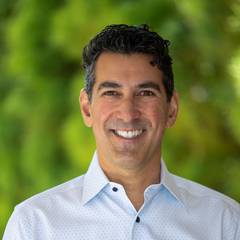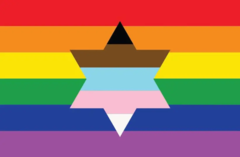the importance of belonging
10/04/2022 06:30:07 PM

Sermon, Kol Nidre 2022/5783
Let me set the stage. There we were. Our ancestors, the Children of Israel, in the wilderness of Sinai. Before we even knew the details, we answered God with one voice, expressing our eagerness to be a holy nation. Standing at the foot of Mount Sinai, we experienced the revelation with God and entered a covenantal relationship with the Divine that would last up to the present day.
As detailed in the heart of the Book of Exodus, we learn through the mitzvot the kind of community God calls on us to create. How will we treat each other and our tradition? We are to worship Adonai and Adonai only, we are to make the Sabbath day holy, honor our mother and father, and we are commanded not to murder, commit adultery, steal, swear falsely, or let jealousy lead us to commit wrong. And that’s just the Ten Commandments. What follows is a full array of laws and ideas that read a lot like tort law, but they’re really about creating a community where we can count on and trust each other.
But something was missing. All these mitzvot were crucial, but as ethicist Leon Kass writes, the great revelation at Sinai didn’t fill all the needs we would have as a spiritual people. What was missing? It would be the “deep longing of human beings to be in touch with what is highest and best, to relate directly with the divine.”[1] And so, God concludes the Book of Exodus with the detailed plan to build the mishkan, the tabernacle or sanctuary, where the people may experience the nearness, the presence of God. “V’asu Li mikdash v’shakhanti b’tokham—and let them make Me a sanctuary that I may dwell among them,” God tells Moses.[2]
The sanctuary would be the biblical precursor to the ancient Temples in Jerusalem and the synagogues throughout history and our time. It’s where we came to feel the presence of God in a way that sometimes was harder to feel elsewhere. And it became the central dwelling place for the people. A lot of people. People from different backgrounds. I’m talking about our biblical ancestors, and I’m talking about our community today. Our ancestors were from Egypt, our Torah tells us, but they weren’t one. They were twelve. They were from twelve different tribes, with different leaders, interests, personalities, and goals. But with their relationship with God, they had a unifying vision—a mission—and with the sanctuary, they had a spiritual home.
We are of another generation, place, and time. But we have fundamentally similar needs. And our long journey through Covid has only underscored those acute needs. We too need to connect—with something spiritual, with other people, and where we feel a profound connection to a shared sense of eternal values. I dare say, it can be a challenge how idea-driven our faith is. We don’t have a physical representation of our god. We have no statues, and no intermediaries. What we do have is ideas and rituals. So, coming together, in one space at the same time is very important.
Covid and its realities has made it harder to come together. Some of us are not able to come together for health reasons, or distance, but I’m so glad that you are here, from wherever you are tuning in. Thanks to technology, there are so many more ways to make interpersonal connections and create community. After almost three years of living with Covid, though, I want to suggest that this year we commit ourselves ever more strongly to our sacred community, our Peninsula Temple Sholom, because this is where we belong. And that’s such a precious and beautiful thing.
Like the Israelites, we come from myriad backgrounds and live different lives. But this is one place where all of us can come and share joy together, learn together, and worship together. This is where we do something holy, create something holy, and serve a higher purpose together. Like the ancient Israelites, we come together, from at least twelve different metaphorical tribes, to create one Temple Sholom community. My call to all of us this year is this: let’s make this a year of belonging and engaging.
Our prayers on this day remind us continually that we may walk in as individuals, but when we gather on Kol Nidre, we’re part of one community, or kehillah. Some moments ago, Cantor Kliger led us in chanting the confessional prayer, Ashamnu. The great mystic, Rabbi Isaac Luria wrote: “Why was confession composed in the plural, so that we say, ‘We have sinned,’ rather than, ‘I have sinned,’? Because all Israel is one body and everyone of Israel is a limb of that body; that is why we are all responsible for one another when we sin. So, if one’s fellow should sin, it is as though one has sinned oneself; therefore, despite the fact that one has not committed that iniquity, one must confess to it.”[3] In our tradition, no sinner—and that’s all of us—stands alone.
Tomorrow morning we’ll hear these words chanted: “You stand this day, all of you, before your God Adonai. . .” The whole community, from the tribal heads and elders to the woodchopper and water carrier. The stranger, the officials. Men, women, and children were there to enter the covenant with God. And that covenant established a relationship with God that transcended time. That covenant bound them, and it binds us to God.[4]
None of it is individual. All of it is collective and communal. Every one of us is here together tonight, every one of us with our neighbor. In our tradition, this is how we affirm we are part of a collective people. We come from different tribes, but we make up a collective whole that is one. There is a mutual responsibility to each other, and that’s what belonging means. At a moment in time when our country is torn apart by divisiveness, we need to hold on to our values of community and belonging.
In a recent podcast, Rabbi Sarah Stutman expressed that our American capitalist culture gives us the deeply false and dangerous notion that we are not interconnected.[5] We need each other to fully thrive. And that’s why we have to consciously rid ourselves of some Covid-era habits and patterns. Emotionally, spiritually, socially, we need community, we need to belong. I know that the pandemic is not over, and some don’t feel safe still in all communal situations. I hope that this year, every one of us will deepen our level of connection. And that can take many forms. If you’re comfortable, please come back in person to services, to a program, to be part of a social action event. If you’re not comfortable yet, some programs are online. Or make an appointment with a member of our clergy team, and we will happily sit outside with you in our beautiful meditation garden to reconnect.
Our earliest sacred literature demonstrates how much community is wrapped into our customs and rituals. The Torah teaches that on the Shalosh R’galim—Sukkot, Passover, and Shavuot— we are to gather. Where? That place would come to be the Temple in Jerusalem and would attract pilgrims from all over the ancient Near East. And the verb used in the text is deeply meaningful. The wording doesn’t say we should go, or that we should come, but rather yeiraeh—appear, which comes from the Hebrew root reish, aleph, hay, meaning to be seen. Three times a year we were called on to appear and be seen, by God, and the community of Israel.[6]
And listen to this. The Mishnah instructs that all who entered the Temple Mount enter from the right and then circled to the left, except for these people. The person to whom, and I quote, “something had happened,” which I interpret to mean someone who was vulnerable. And that person would enter from the left and go out by the right. And when we would notice somebody who was going clockwise as opposed to counterclockwise, we were supposed to notice and ask, “Why do you go round to the left?” And then the person might answer, “Because I am a mourner.” And then the person should respond with, “May God who dwells in this house comfort you.” And even if the person had been cast out by the community and responded with, “Because I am excommunicated,” the person should respond with, “May God who dwells in this house inspire you to listen to the words of your colleagues so that they may draw you near again.”[7]
Rabbi Stutman draws out the implication that in our ancient cultural center, the Temple, vulnerable people were made to be visible, heard and lifted up. Quite literally, whichever way you are going, we see you, we hear you, and you should not suffer or hurt alone.[8] And neither should we. Because this is where we belong and where we model communal support.
All of us need this community. Our adults, our teens, and our children. We all need precious human connection and human contact. Our synagogue community can play an important role in our reconnecting after nearly three years of Covid.
I heard a beautiful song the other day, called A Human Touch, by Jackson Browne and Leslie Mendelson, and it made me think about our Sholom community. We come to this house, this sanctuary, and feel the presence of God, and, what we also need so desperately, is to feel the connection with other human beings. The song goes like this:
“Everybody gets lonely
Feels like it's all too much
Reaching out for some connection
Or maybe just their own reflection
Not everybody finds it
Not like the two of us
Sometimes all anybody needs
Is a human touch
Sometimes all anybody needs
Is a human touch”[9]
Tonight, we come together in our beautiful sanctuary to look for God and this is where we look for the human touch. This is where we find each other, as well as smiles, kindness, and warmth. Let us recommit this year to belonging at Peninsula Temple Sholom. May we engage fully and may we find the holy, each other, and our true selves. Cain yehi ratzon, so may this be God’s will. Amen.
[1] Leon Kass, “Exodus and American Nationhood,” The Wall Street Journal, January 8, 2021, https://www.wsj.com/articles/exodus-and-american-nationhood-11610121319
[2] Exodus 25:8, The Torah: A Women’s Commentary, ed. by Tamara Eskenazi and Andrea Weiss (New York: URJ Press, 2008) 454.
[3] Moments of Transcendence: Inspirational Readings for Yom Kippur, edited by Rabbi Dov Peretz Elkins (Northvale: Jason Aronson Inc., 1992) 97.
[4] Deuteronomy 29:9-14, The Torah, ed. by Eskenazi and Weiss, 757.
[5] Rabbi Sarah Stutman, chutzpod, September 22, 2022.
[6] Deuteronomy 16:16, The Torah, ed. by Eskinazi and Weiss 1133.
[7] Babylonian Talmud, Tractate Middot 2:2.
[8] Stutman, chutzpod, September 22, 2022.
[9] Jackson Browne and Leslie Mendelson, A Human Touch, 2021.






